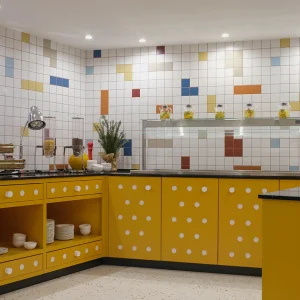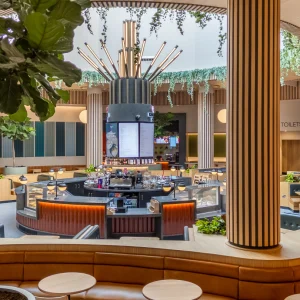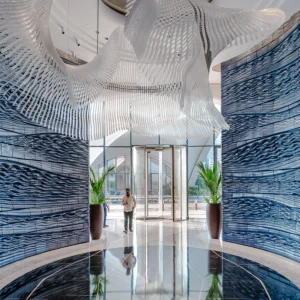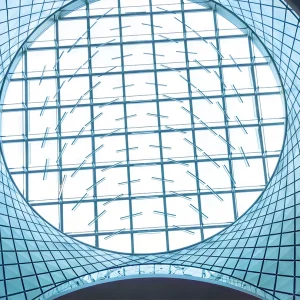
Given the commercial power wielded by this conglomerate in determining architecture and design discourse, it is perhaps ironic that the first speaker, Will Alsop, proclaims death to the paradigms of society as we know it. In his optimistic worldview, we are,apparently witnessing the final throes of late capitalism in all of its guises – ‘post-press, post-corporate, post-banking, post-supermarket’. Just when we’re about to give up on beauty, the topic of the session, he demands a show of hands. Hemel Hempstead high street is ugly, by popular consensus.
The minimalist interior of a monastery designed by a Dutch monk – Dom Hans van der Laan – is, by contrast, beautiful. Precisely what this tells us remains unclear, as slides of Alsop’s buildings pop up in their own crazed, spidery magnificence. While despising corporate branding, he clearly sees his own icon making as of an entirely different ilk. The afterlife of buildings as nicknames in the marketing of Place – or, even better, fancy dress costumes – is his ultimate seal of approval. Is this the result of a democratic architectural process, or merely the triumph of kitsch?
If Alsop is the architect as creator-for-the-people, then Stephen Bayley, up next, is the journalist as gentleman-connoisseur. Bayley knows beauty – he’s recently written a book on the subject. The main hypothesis here is that beauty and ugliness are two sides of the same coin, but that this is a different coin to attractive and unattractive. Beauty can be boring and soporific, while ugliness challenges existing conventions. When you get past his overblown speaking style – which involves scrunching up each sheet of notes and casting it flamboyantly aside – some of these points are good. Buildings acquire a patina of beauty through time, as related in particular to their standing in national identity. He draws attention to the recent report championed by planning minister Nick Bowles proposing to replace tower blocks with traditional terraced streets: an unprecedented move in bringing popular conceptions of beauty to the fore of governmental debate. For Alsop, too, housing is the arena in which this discussion expresses itself most forcibly. While he presents the hidden, artful detailing of modernist blocks as the key to their beauty, such as a strange cast concrete rock on the famous roof of Corbusier’s Unité, Bayley is a little behind the game in forecasting the ‘future’ popularity of Goldfinger’s Trellick Tower.
Finally, Will Hunter of the Architectural Review opens a roundtable discussion by suggesting that the relationship with religious architecture – a topic covered by both Alsop and Bayley – might be an indication that beauty is beyond rational thought. To the contrary, the sense of awe created by ecclesiastical spaces is a very direct result of their pragmatic function, or lack thereof. The trick is to translate this ‘spirituality’ into spaces for the economic and practical realities of everyday life. Alsop’s own offering, that beauty might be found through the proliferation of choice in our domestic environment, is merely an exacerbation of the lifestyle capitalism he claims to disdain. It is no accident that the buildings we find ‘beautiful’ can be sorted into the same categories as our preferred supermarket, clothes retailer, or choice of newspaper.
Architecture & Beauty: Stephen Bayley and Will Alsop in conversation
Victoria & Albert Museum, London
19th February 2013
Tom Brooks





